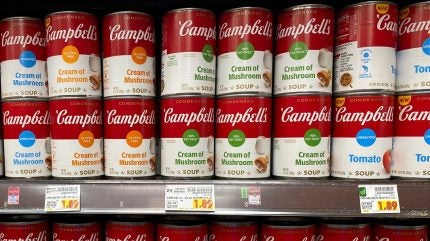
US consumers cooking at home “at the highest levels” in five years boosted sales at The Campbell’s Company in its latest quarter.
In the three months to 27 April, Campbell’s generated net sales of $2.5bn, up 4% year on year. Sales increased 1% on an organic basis “primarily driven by 2% favourable volume/mix”.

Discover B2B Marketing That Performs
Combine business intelligence and editorial excellence to reach engaged professionals across 36 leading media platforms.
Campbell’s said the volume/mix within its Meals & Beverages division jumped 7%, driving a 6% rise in organic sales. The unit’s reported third-quarter net sales stood at $1.46bn.
However, volume/mix from Campbell’s Snacks division dropped 5%, leading to a 5% decline in organic sales.
The company said the “segment operating earnings” from Meals & Beverages rose 8% to $248m but fell 13% in Snacks to $145m.
Campbell’s president and CEO Mick Beekhuizen said the company’s third-quarter results were “solid” and “exceeded our expectations”, although conceded it was “partially due to favourable shipment timing”.

US Tariffs are shifting - will you react or anticipate?
Don’t let policy changes catch you off guard. Stay proactive with real-time data and expert analysis.
By GlobalDataHe added: “Consumers are cooking at home at the highest levels since early 2020 and turning to our brands for value, quality and convenience. Within Snacks, performance was mixed across the portfolio, and while we’re benefiting from some strong innovation launches, we are adjusting our plans to make sure we’re competitive across our full brand portfolio.”
Speaking to analysts on a call to discuss the results, Beekhuizen was asked if he had “optimism” the home-cooking trend would continue.
He said: “I feel very good about the meals and beverages portfolio in light of some of the trends that we’re seeing with regard to the consumer and the continued focus on cooking at home in combination with our portfolio and the breadth of our portfolio.
“Now that being said, I don’t expect us per se to repeat the Q3 results as we are coming out of the soup season obviously but, all set, I feel good about where we’re at and I still believe that there’s a lot of opportunity going forward within the portfolio.”
The third-quarter results included a 35% drop in EBIT to $161m amid a $150m charge of related to the Snyder’s of Hanover trademark. Adjusted EBIT was up 2% at $362m.
“Based on recent performance, we lowered our long-term outlook and recognised an impairment charge of $150m on the trademark, reducing its carrying value on our balance sheet to $470m,” a Campbell’s spokesperson told Just Food.
Net earnings more than halved year on year from $133m to $66m. Adjusted net earnings dropped 3% to $218m.
X said Snyder’s of Hanover appealed to “the pretzel traditionalist” and added: “On Snyder’s of Hanover, we continue to proactively manage our assortment to higher-performing items and invest in expanding convenient portion-controlled packs but this was not enough to offset the category competitive pressures.”
More broadly on snacks, the Campbell’s chief said the categories in which the company competes “deteriorated” compared to the second quarter amid declining consumer confidence.
“On top of it, the consumer continues to become increasingly intentional and that is really that focus on value-added for you and indulgence,” Beekhuizen said.
Brands such as Pepperidge Farm were helped by new products, he added. “I expect us to continue to focus on innovation, which is important, as the consumer … is really intentional about the dollars that they’re spending.”
Nevertheless, Beekhuizen conceded Campbell’s now expects a “recovery” from its snacks business in its 2025/26 financial year, compared to its previous estimates of it occurring before the current fiscal period was out.
“I expect that recovery to take place now in fiscal 2026. I do think that’s coming back to the different tactics that I previously described, probably combined with making sure that we continue to invest in our brands,” he said.
“One of the things that you see right now is that we are spending from a marketing and selling perspective at the lower end of our 9-10% range. I do expect that going into next year we might need to lean into that a little bit more as we need to make sure that we support our brands in the marketplace.”





